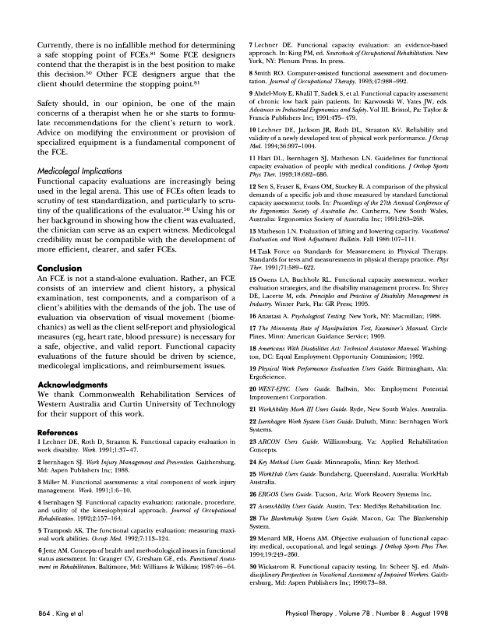A Critical Review of Functional Capacity ... - Physical Therapy
A Critical Review of Functional Capacity ... - Physical Therapy
A Critical Review of Functional Capacity ... - Physical Therapy
Create successful ePaper yourself
Turn your PDF publications into a flip-book with our unique Google optimized e-Paper software.
Currently, there is no infallible method for determining<br />
a safe stopping point <strong>of</strong> FCES.~~ Some FCE designers<br />
contend that the therapist is in the best position to make<br />
this decision.50 Other FCE designers argue that the<br />
client should determine the stopping point.81<br />
Safety should, in our opinion, be one <strong>of</strong> the main<br />
concerns <strong>of</strong> a therapist when he or she starts to formu-<br />
late recommendations for the client's return to work.<br />
Advice on modlfylng the environment or provision <strong>of</strong><br />
specialized equipment is a fundamental component <strong>of</strong><br />
the FCE.<br />
Medicolegal /rnplications<br />
<strong>Functional</strong> capacity evaluations are increasingly being<br />
used in the legal arena. This use <strong>of</strong> FCEs <strong>of</strong>ten leads to<br />
scrutiny <strong>of</strong> test standardization, and particularly to scru-<br />
tiny <strong>of</strong> the qualifications <strong>of</strong> the evaluator.50 Using his or<br />
her background in showing how the client was evaluated,<br />
the clinician can serve as an expert witness. Medicolegal<br />
credibility must be compatible with the development <strong>of</strong><br />
more efficient, clearer, and safer FCEs.<br />
Conclusion<br />
An FCE is not a stand-alone evaluation. Rather, an FCE<br />
consists <strong>of</strong> an interview and client history, a physical<br />
examination, test components, and a comparison <strong>of</strong> a<br />
client's abilities with the demands <strong>of</strong> the job. The use <strong>of</strong><br />
evaluation via observation <strong>of</strong> visual movement (biome-<br />
chanics) as well as the client self-report and physiological<br />
measures (eg, heart rate, blood pressure) is necessary for<br />
a safe, objective, and valid report. <strong>Functional</strong> capacity<br />
evaluations <strong>of</strong> the future should be driven by science,<br />
medicolegal implications, and reimbursement issues.<br />
Acknowledgments<br />
We thank Commonwealth Rehabilitation Services <strong>of</strong><br />
Western Australia and Curtin University <strong>of</strong> Technology<br />
for their support <strong>of</strong> this work.<br />
References<br />
1 Lechner DE, Roth D, Straaton K. <strong>Functional</strong> capacity evaluation in<br />
work disability. \Vork. 1991;1:37-47.<br />
7 Lechner DE. <strong>Functional</strong> capacity evaluation: an evidence-based<br />
approach. In: King PM, ed. Sourcebook <strong>of</strong> OcrupatzonalRehabilitation. New<br />
York, tW Plenum Press. In press.<br />
8 Smith RO. Computer-assisted functional assessment and documen-<br />
tation. Journal <strong>of</strong> Occupational <strong>Therapy</strong>. 1993;47:988-992.<br />
9 Abdel-Moty E, Khalil T, Sadek S, et al. <strong>Functional</strong> capacity assessment<br />
<strong>of</strong> chronic low back pain patients. In: Kanvowski W, Yates JW, eds.<br />
Aduances in I7rdustrialErgonomics and Safety. Vol 111. Bristol, Pa: Taylor &<br />
Francis Publishers Inc; 1991:475-479.<br />
10 Lechner DE, Jackson JR, Roth DL, Straaton KV. Reliability and<br />
validity <strong>of</strong> a newly developed test <strong>of</strong> physical work performance. J Occup<br />
Med. 1994;36:997-1004.<br />
11 Hart DL, Isernhagen SJ, Matheson LN. Guidelines for functional<br />
capacity evaluation <strong>of</strong> people with medical conditions. J Chthop Spods<br />
Phys Ther. 1993;18:682-686.<br />
12 Sen S, Fraser K, Evans OM, Stuckey R. A comparison <strong>of</strong> the physical<br />
demands <strong>of</strong> a specific job and those measured by standard functional<br />
capacity assessmerlt tools. In: Proceedings <strong>of</strong> the 27th Annual Conference <strong>of</strong><br />
the Ergonomics Society <strong>of</strong> Australia Inc. Canberra, New South Wales,<br />
Australia: Ergonomics Society <strong>of</strong> Australia Inc; 1991:26.3-268.<br />
13 Matheson LN. Evaluation <strong>of</strong> lifting and lowering capacity. Vocational<br />
Eualuation and Work Adjustment Bulletin. Fall 1986: 107-1 11.<br />
14 Task Force on Standards for Measurement in <strong>Physical</strong> <strong>Therapy</strong>.<br />
Standards for tests and measurements in physical therapy practice. Phys<br />
Ther. 1991;71:589-622.<br />
15 Owens LA, Buchholz RL. <strong>Functional</strong> capacity assessment, worker<br />
evaluation strategies, and the disability management process. In: Shrey<br />
DE, Lacerte M, eds. Principles and Practices <strong>of</strong> Disability Management in<br />
Industry. Winter Park, Fla: GR Press; 1995.<br />
16 Anastasi A. Psychological Testing. New York, NY: Macmillan; 1988.<br />
17 The Minnesota Rnte <strong>of</strong> Manipulation Test, Examiner's Manual. Circle<br />
Pines, Minn: American Guidance Service; 1969.<br />
18 Americans With Disabilities Act: Technical Assistance Manual. Washing-<br />
ton, DC: Equal Employment Opportunity Commission; 1992.<br />
19 <strong>Physical</strong> Work Perfomnanc Eualuation Users Guide. Birmingham, Ala:<br />
Ergoscience.<br />
20 \VEST-EPIC Users Guide. Ballwin, Mo: Employment Potential<br />
Improvement Corporation.<br />
21 WorkAbility Mark III Users Guide. Ryde, New South Wales. Australia.<br />
22 Isernhagen Work System Users Guide. Duluth, Minn: Isernhagen Work<br />
Systems.<br />
23ARCON Users Guide. Williamsburg, Va: Applied Rehabilitation<br />
Concepts.<br />
2 Isernhagen SJ. Ubrk Injury Management and Pra~mtion. Gaithersburg, 24 Kq Method Users Guide. Minneapolis, Minn: Key Method.<br />
Md: Aspen Publishers Inc; 1988.<br />
25 WorkHab Usvs CjUid~. Bundaberg, Queensland, Australia: WorkHab<br />
3 Miller M. <strong>Functional</strong> assessments: a vital component <strong>of</strong> work injury Australia.<br />
management. Work. 199 1;1:6-10.<br />
26 ERGOS Users Guide. Tucson, Ariz: M'ork Reovery Systems Inc.<br />
4 Isernhagen SJ. <strong>Functional</strong> capacity evaluation: rationale, procedure.<br />
and utility <strong>of</strong> the kinesiophysical approach. Journal <strong>of</strong> Occupational<br />
27 AssessAbility Users Guide. Austin, Tex: MediSys Rehabilitation Inc.<br />
Rehabilitation. 1992;2: 157-164. 28 The Blankenship System Users hide. Macon, Ga: The Blankenship<br />
5 Tramposh AK. The functional capacity evaluation: measuring maxi-<br />
System.<br />
mal work abilities. Orcup Med. 1992;7:113-124. 29 Menard MR, Hoens AM. Objective evaluation <strong>of</strong> functional capac-<br />
6 Jette AM. Concepts <strong>of</strong> health and methodological issues in functional<br />
status assessment. In: Granger CV, Gresham GE, eds. Atnctional Anessity:<br />
medical, occupational, and legal settings. J Orthop Sports Phys Ther.<br />
1994;19:249-260.<br />
mat in Rehabilitation. Baltimore, Md: Williams & Wilkins; 1987:46-64. 30 Wickstrom R. <strong>Functional</strong> capacity testing. In: Scheer SJ, ed. Multidisciplinary<br />
Perspectives in Vocational Assessment <strong>of</strong> Intpaired Workers. Gaithersburg,<br />
Md: Aspen Publishers Inc; 1990:73-88.<br />
864 . King et al <strong>Physical</strong> <strong>Therapy</strong> . Volume 78 . Number 8 . August 1998
















